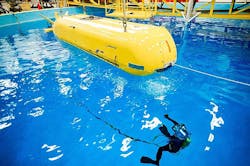Navy developing revolutionary new propulsion for manned and unmanned undersea vehicles
Officials of the Naval Undersea Warfare Center NUWC Division in Keyport, Wash., are considering awarding a sole-source contract to Applied Physical Sciences Corp. in Gorton, Conn., to continue the company's research in undersea vehicle propulsion and structures.
Applied Physical Sciences and several other defense companies are trying to develop and demonstrate integrated underwater vehicle prototypes able to operate at speed and range combinations previously unachievable in fixed-size platforms, while retaining traditional volume and weight fractions for payloads and electronics.
These efforts are part of the Blue Wolf program of the U.S. Defense Advanced Research Projects Agency in Arlington, Va. NUWC officials are asking for industry's help to help them decide whether to issue a formal solicitation for Applied Physical Sciences to continue its Blue Wolf research.
Applied Physical Sciences won a $3.1 million Blue Wolf contract in July 2015. Other contractors working on the Blue Wolf project are Boeing Defense, Space & Security segment in Huntington Beach, Calif.; the Lockheed Martin Mission Systems and Training segment in Riviera Beach, Fla.; and the Charles Stark Draper Laboratory in Cambridge, Mass.
Applied Physical Sciences is developing electric sources like fuel cells and batteries that can fit within an undersea vehicle system module. This involves developing thermal, electrochemical, and energy-harvesting with two or more energy sources to improve energy efficiency measured in Watt hours per mile.
The Blue Wolf project also involves developing alternative point designs for a fast, low-drag, and energy-efficient undersea vehicle, as well as revolutionary technologies for significant drag reduction, such as dynamic lift from winglets, body shaping, coatings, and drag-reduction technologies to improve system energy efficiency.
Undersea vehicle size, weight, and volume, traditionally are limited by handling, launch, and recovery systems, DARPA officials explain. Mission performance typically sets the range, endurance, speed, and depth requirements, and the range of underwater vehicles is limited by the amount of energy available for propulsion and the power required for a given underwater speed.
This means that for a given speed, range, and volume necessary for payloads and electronics, vehicle size is proportional to energy needed for the mission envelope.
While designers can modify this envelope by reducing hydrodynamic drag, improving lift-to-drag performance, or by improving the volumetric energy density of energy sources, the volume and weight needed for systems to reduce drag or improve lift-to-drag in a fixed-size vehicle also reduces the volume and weight available for energy.
Related: New era dawns in ASW as manned and unmanned submarines team for bistatic sonar
The Blue Wolf program seeks to break free of these limitations by focusing on rapid testing and maturation of novel energy, hydrodynamic lift, and drag-reduction technologies.
Testing will be on existing undersea vehicles at the U.S. Naval Undersea Warfare Center (NUWC) in Newport, R.I., and at the Penn State Applied Research Laboratory in Reston, Va. NUWC will manage safety, certification, and vehicle development, while Penn State will provide technical expertise.
The initial reference architecture consists of a 21-inch-diameter vehicle with volume and weight reserved for baseline guidance, control, electronic systems, and payload section. The vehicle will use a baseline electric drive and conventional fin control.
NUWC is gathering information from industry to help determine if Advanced Physical Sciences' work should continue. Email responses by 19 June 2018 to the Navy's Winston Dimagiba at [email protected].. More information is online at https://www.fbo.gov/spg/DON/NAVSEA/N00253/N00253-15-C-1001-P00017/listing.html.
Ready to make a purchase? Search the Military & Aerospace Electronics Buyer's Guide for companies, new products, press releases, and videos
